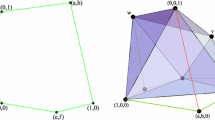Abstract
We revisit a well studied linear algebraic problem, computing the rank and determinant of matrices, in order to obtain completeness results for small complexity classes. In particular, we prove that computing the rank of a class of diagonally dominant matrices is complete for \(\textsf{L}\) . We show that computing the permanent and determinant of tridiagonal matrices over ℤ is in \(\textsf {Gap} \textsf {NC}^{1}\) and is hard for \(\textsf {NC}^{1}\) . We also initiate the study of computing the rigidity of a matrix: the number of entries that needs to be changed in order to bring the rank of a matrix below a given value. We show that some restricted versions of the problem characterize small complexity classes. We also look at a variant of rigidity where there is a bound on the amount of change allowed. Using ideas from the linear interval equations literature, we show that this problem is \(\textsf {NP}\) -hard over ℚ and that a certain restricted version is \(\textsf {NP}\) -complete. Restricting the problem further, we obtain variations which can be computed in \(\textsf {PL}\) and are hard for \(\textsf {C}_{=}\textsf {L}\) .
Similar content being viewed by others
References
Allender, E., Ambainis, A., Mix Barrington, D.A., Datta, S., LeThanh, H.: Bounded-depth arithmetic circuits: counting and closure. In: Proc. 26th ICALP. Lecture Notes in Computer Science, vol. 1644, pp. 149–158. Springer, Berlin (1999)
Allender, E., Arvind, V., Mahajan, M.: Arithmetic complexity, Kleene closure, and formal power series. Theory Comput. Syst. 36(4), 303–328 (2003)
Allender, E., Beals, R., Ogihara, M.: The complexity of matrix rank and feasible systems of linear equations. Comput. Complex. 8(2), 99–126 (1999)
Àlvarez, C., Greenlaw, R.: A compendium of problems complete for symmetric logarithmic space. Comput. Complex., 9, 73–95 (2000)
Allender, E.: Arithmetic circuits and counting complexity classes. In: Krajicek, J. (ed.) Complexity of Computations and Proofs. Quaderni di Matematica, vol. 13, pp. 33–72. Seconda Universita di Napoli, Napoli (2004)
Allender, E., Ogihara, M.: Relationships among PL, #l, and the determinant. RAIRO Theor. Inform. Appl. 30(1), 1–21 (1996)
Buntrock, G., Damm, C., Hertrampf, U., Meinel, C.: Structure and importance of logspace MOD-classes. Math. Syst. Theory 25, 223–237 (1992)
Buss, J.F., Frandsen, G.S., Shallit, J.: The computational complexity of some problems of linear algebra. J. Comput. Syst. Sci. 58, 572–596 (1999)
Bollobas, B.: Modern Graph Theory. GTM, vol. 184. Springer, Berlin (1984)
Cook, S.A., McKenzie, P.: Problems complete for L. J. Algorithms 8, 385–394 (1987)
Caussinus, H., McKenzie, P., Thérien, D., Vollmer, H.: Nondeterministic \(\textsf{NC}^{1}\) computation. J. Comput. Syst. Sci. 57, 200–212 (1998)
Dahl, G.: A note on nonnegative diagonally dominant matrices. Linear Algebra Appl. 317, 217–224 (1999)
Damm, C.: DET = L(#L). Technical Report Informatik-Preprint 8, Fachbereich Informatik der Humboldt–Universität zu Berlin (1991)
Deshpande, A.: Sampling-based dimension reduction algorithms. PhD thesis, MIT, May 2007
Geelen, J.F.: Maximum rank matrix completion. Linear Algebra Appl. 288(1–3), 211–217 (1999)
Garey, M.R., Johnson, D.S.: Computers and Intractability: A Guide to the Theory of NP-Completeness. Freeman, New York (1979)
Grigoriev, D.Y.: Using the Notions of Separability and Independence for Proving the Lower Bounds on the Circuit Complexity. Notes of the Leningrad Branch of the Steklov Mathematical Institute. Nauka, Moscow (1976) (in Russian)
Kulkarni, R.: Personal communication, January 2007
Laurent, M.: Matrix completion problems. In: Floudas, C.A., Pardalos, P.M. (eds.) The Encyclopedia of Optimization, vol. 3, pp. 221–229. Kluwer, Dordrecht (2001)
Lokam, S.V.: Spectral methods for matrix rigidity with applications to size-depth tradeoffs and communication complexity. In: Proc. 36th FOCS, pp. 6–15, 1995; J. Comput. Syst. Sci. 63(3):449–473 (2001)
Marcus, M., Minc, H.: A Survey of Matrix Theory and Matrix inequalities. The Prindle, Weber and Schmidt Complementary Series in Mathematics, vol. 14. Allyn and Bacon, Boston (1964)
Mulmuley, K.: A fast parallel algorithm to compute the rank of a matrix over an arbitrary field. Combinatorica 7, 101–104 (1987)
Murota, K.: Mixed matrices—irreducibility and decomposition. In: Brualdi, R.A., Friedland, S., Klee, V. (eds.) Combinatorial and Graph-Theoretic Problems in Linear Algebra. The IMA Volumes in Mathematics and Its Applications, vol. 50, pp. 39–71. Springer, Berlin (1993)
Mahajan, M., Vinay, V.: Determinant: combinatorics, algorithms, complexity. Chic. J. Theor. Comput. Sci. 5 (1997)
Nisan, N., Ta-Shma, A.: Symmetric logspace is closed under complement. Chic. J. Theor. Comput. Sci., (1995).
Poljak, S., Rohn, J.: Checking robust nonsingularity is \(\textsf {NP}\) -hard. Math. Control Signals Syst. 6, 1–9 (1993)
Reingold, O.: Undirected st-conenctivity in logspace. In Proc. 37th STOC, pp. 376–385 (2005).
Rohn, J.: Systems of linear interval equations. Linear Algebra Appl. 126, 39–78 (1989)
Rohn, J.: Checking positive definiteness or stability of symmetric interval matrices is NP-hard. Comment. Math. Univ. Carol. 35, 795–797 (1994)
Razborov, A.A., Rudich, S.: Natural proofs. J. Comput. Syst. Sci. 55(1), 24–35 (1997)
Toda, S.: Counting problems computationally equivalent to the determinant. Technical Report CSIM 91-07, Dept. of Comput. Sci. & Information Mathematics, Univ of Electro-Communications, Chofu-shi, Tokyo (1991)
Valiant, L.G.: Graph theoretic arguments in low-level complexity. In: Proc. 6th MFCS. Lecture Notes in Computer Science, vol. 53, pp. 162–176. Springer, Berlin (1977)
Valiant, L.G.: Why is Boolean complexity theory difficult? In: Proceedings of the London Mathematical Society symposium on Boolean function complexity, pp. 84–94. Cambridge University Press, New York (1992)
Vinay, V.: Counting auxiliary pushdown automata and semi-unbounded arithmetic circuits. In: Proc. 6th Structure in Complexity Theory Conference. Lecture Notes in Computer Science, vol. 223, pp. 270–284. Springer, Berlin (1991)
Vollmer, H.: Introduction to Circuit Complexity: A Uniform Approach. Springer, Berlin (1999)
Author information
Authors and Affiliations
Corresponding author
Rights and permissions
About this article
Cite this article
Mahajan, M., Sarma, J.M.N. On the Complexity of Matrix Rank and Rigidity. Theory Comput Syst 46, 9–26 (2010). https://doi.org/10.1007/s00224-008-9136-8
Received:
Accepted:
Published:
Issue Date:
DOI: https://doi.org/10.1007/s00224-008-9136-8




